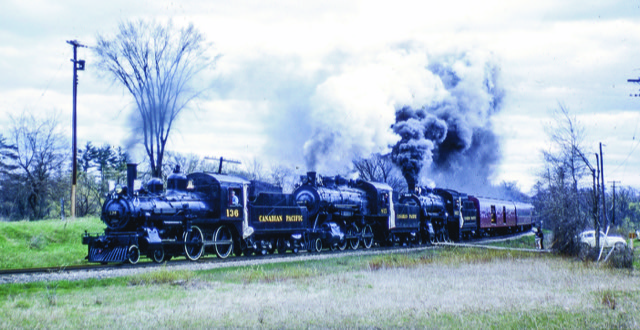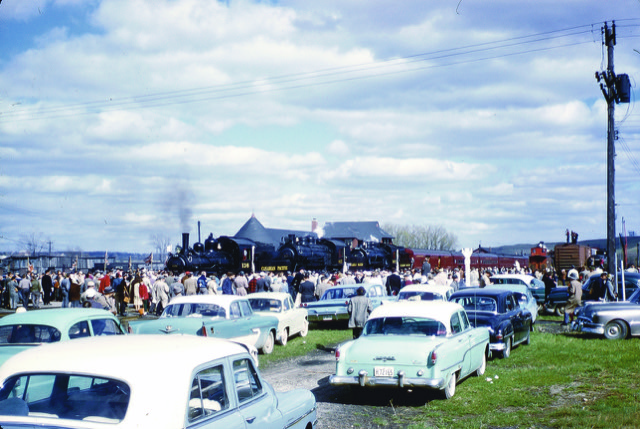Roderick Sergiades
Steam went off the rails with a May Day 60 years ago.
When 1960 debuted, it was the age of black and white TV, no one had ever heard of the Fab Four, and transatlantic jetliners had been flying for a little over a year in the full flight rocket age.

That was also the year the wheels literally came off the tracks for the steam train era. When the Dominion’s two major railways abandoned en masse their once primary mode of propulsion, which dated to 1836, for the oncoming diesel age, scores of steam engines were sent for scrap.
It was the end of the line even as a few were given a reprieve with a new coat of paint for stationary posterity in small town Canada, while an even smaller handful were mechanically restored for occasional excursion service.
With a large banner, the Canadian National Railways publicized its last regularly scheduled passenger steam train that year on April 25, when engine No. 6043 terminated its run in Winnipeg from The Pas, Manitoba.
Upon greeting the just arrived locomotive’s engineer and fireman, the CNR’s Vice President of the Western Region, J. R. McMillan, lamented the steam era’s passing by saying, “that thundering, glamorous giant of the road.”
For the Canadian Pacific Railway, their last passengers to be routinely pulled by iron horses were on their Montreal commuter operations. Widely believed to be June 26, CPR steam engines brought their commuters into Windsor station that Monday morning for the last time. The afternoon and evening runs were entirely diesel.
Just over a month later, both major railways saw the end of their steam-powered freight services, when noted Canadian railway historian Ron Ritchie watched the CPR’s 2-8-2 (wheel arrangement) 5441 run an extra grain train from Winnipeg to Kenora, Ontario on July 27. After that for a brief time minor ‘roads’ in Nova Scotia and Saskatchewan used steam to transport coal. Some B.C. logging railways, as well as other small industrial and short lines, also continued with temporary steam. Even as late as March 1961, there was still some very minor Montreal steam engine yard activity. Surprisingly, a paper mill in Iroquois Falls, Ontario was still using a larger steam locomotive in 1965!
Only 1.4 per cent of all locomotives were still steam powered when the ’60s dawned; ten years earlier it had been 91 per cent.

‘Sentimental Journey, The Last Run.’
(Picture courtesy of Old Time Trains
(http://www.trainweb.org/oldtimetrains/stories/tripleheader1.html)
Labour and fuel costs made diesel engines much more economical. They required far less maintenance and had roughly 30 per cent thermal efficiency (converting fuel to energy) versus the typical 6 to 7 per cent for steam locomotives. Yet when both mainlines received their first diesels in the late ’40s, the CNR and CPR quickly learned steam still triumphed in power and speed.
In a quest to boost the bottom line in freight and especially passenger service, the CNR and CPR began an intensive diesel programme in 1955, when diesel was no longer steam’s little brother. That year, as Canada’s population grew, passenger trains accounted for less than 10 per cent of their overall revenue, when 27.2 million trips took place much of it on new coaches. A decade earlier, the railways had earned 20 per cent of their earnings from 55.4 million passengers who had not yet discovered the ‘delights’ of automobiles and airplanes.
With the steam era entering its twilight year, a few aficionados took it upon themselves to organize excursions by hiring the railways to run special trains. Small in scale they amounted to just a few such runs, but with one notable exception that became the granddaddy of them all. It was also the very last time a triple-headed (engine) steam train ever ran in Canada.
Taking place on May Day 1960, the CPR sold 1,057 tickets (children under 5 rode free) resulting in over 1,100 passengers boarding 14 cars at Toronto’s Union Station for a blast-from-the-past round trip to Orangeville, Ontario. Hundreds more had been turned down when tickets sold out three weeks in advance and, yet, because of the great public demand, two more coaches had been added. The Sunday May 1st train that departed at 10:45 a.m. now included ten modern steel coaches, one baggage and one dining car, as well as two old wooden coaches to add an extra air of nostalgia.

Led by North America’s oldest operating steam engine, the 1883-built 4-4-0 136, she was one of the first five locomotives ever ordered by the CPR. Following the 136 were two 4-6-0s, 815 (1908) and 1057 (1912).
Planned, promoted and organized by Railfans Unlimited’s sole member, 18-year-old CPR employee and die-hard railroader R. L. Kennedy (who operates trainweb.org/oldtimetrains/), thousands watched the ‘Sentimental Journey’, as this excursion came to be called.
This trip was so popular it even attracted many steam enthusiasts from the United States, but it was almost for naught.

The official end of Toronto steam operations in December 1959 had severely reduced the choice of locomotives available, not just in number, but also in type, as the Orangeville Subdivision track could only handle smaller engines due to their lighter weight. This forced the dedicated teenager to pay the CPR $1,000 (when earning just $15 a day) out of his own pocket to have 136 moved from New Brunswick to Toronto. As luck would have it, 136 was still available because a New Brunswick bridge could not take the weight of CP’s lightest diesels. Yet 136’s boiler was just six days from being condemned, which was the fate greeting 815’s boiler at the trip’s conclusion.

The CPR designated this excursion as a ‘Passenger Special’, which meant no detail was spared. All engines were repainted with passenger trim, including white-painted tyres (wheels; tenders too) and red paint applied inside bells and to valve handles, etc. Naturally, the cabs’ brass gauges and fittings were polished and black surfaces were freshly repainted. The cabs acquired new white-canvas side curtains, new white flags, and even new white bell ropes. The engines were dressed in their Sunday best!
The train picked up more passengers at West Toronto and Streetsville, and even stopped at the octagonal wooden water tower by Inglewood to fill up. While exiting the scenic Forks of the Credit, the engines’ wheel flanges screamed and the rails groaned, as the locomotives struggled with sharp bends and an S curve while moving upgrade. It was easily the hardest stretch of the trip.

CPR steam train in Orangeville, Ontario.
(Picture courtesy of Old Time Trains
http://www.trainweb.org/oldtimetrains/stories/tripleheader1.html)
Over 1,500 people, a brass band, and an Orangeville train station decked out in Union Jacks and the Stars and Stripes, comprised the grand civic reception.
Widely captured on film, both moving and still, it was also professionally recorded and produced as a vinyl LP (the first in Canada) entitled ‘Sentimental Journey, The Last Run’. It nicely documented the grunting, hissing steam engines and related sounds to which the author can attest while writing this article.
When the time came to leave, each engine was rotated on the turntable for the trip home.

Today, 815 exists only in memory and the iron horse is long gone from Canada’s commercial railways. Yet the romance of steam lives on in a few heritage rail outfits, including the South Simcoe Railway (southsimcoerailway.ca) in Tottenham, Ontario. There a refurbished 136 steams again and the 1057 awaits a return to glory when funds warrant it, whilst diesel- and more likely electrically-powered passenger trains and liners will be the great transportation modes of the 21st century.

